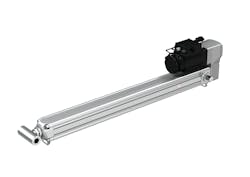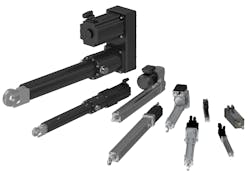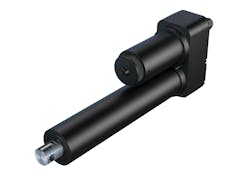Electric Actuators Shine in Lower Horsepower Applications
Hydraulic systems are, and will remain, an important part of many mobile machinery applications. But there are some instances in which it can make sense to convert to electric actuator options, such as when needing an oil-free solution or improving the efficiency of battery-electric machines.
According to Kirk Martin, Sector Sales Director Mobile Machinery at Ewellix, a Schaeffler Company, lower horsepower applications with limited actuation needs are those for which electric actuators can provide a viable alternative to hydraulics.
In this interview with Power & Motion Martin discusses why the transition from hydraulic to electric is taking place, the benefits most suited to using electric actuators and the benefits, as well as challenges, with moving to fully electric actuation.
Editor’s Note: Questions and responses have been edited for clarity.
Power & Motion (P&M): What is driving the shift away from hydraulic technologies to electric actuators in mobile machinery applications?
Kirk Martin (KM): It is kind of connected with the electrification movement going on within the off-road world [and] the trend toward zero emissions. They [OEMs] always look at that as the first step, to replace the internal combustion engine with a battery system. And then the second step a lot of times they want to make it more efficient, or they want to have oil-free features, and the electric actuation system can do both of those. So those are two of the main driving forces.
P&M: Where are you seeing electric actuators replacing hydraulics in mobile equipment – are there specific types of systems or machines where this is occurring?
KM: There's a couple of companies that have fully electric machines out there, one of them is in the scissor lift market and then there's another in the small construction equipment market. Those are the only two so far, but there's several projects we're working on [and] I'm sure other people are working on. Anywhere from the AWP (aerial work platform) markets to the work truck space [are using electric actuators], and also agricultural equipment has used electric actuators for many years but now they're starting to look at a few hydraulic replacement applications.
In general, most projects are under 50 kW (75 hp), [that is] the size machine that [many are] looking at. But we've got projects in all those different industries around the globe.
P&M: Is there a particular reason those lower horsepower applications are being looked at, is it just that’s where the technology is currently?
KM: For us and our company that’s where we have the technology. We do get requests for larger applications, but it fits cost wise with what’s out there [and] what the batteries can do. It makes sense is in the smaller machines [many of which] are going into municipalities where they want to have zero emissions. There are bigger equipment applications that [are aiming for] zero emissions but for us electric actuators are fitting into [applications] under 50 kW. It’s a good guideline for what our projects are following.
P&M: What are the best use cases for electric actuators in mobile machines?
KM: The applications we’re seeing where it makes the most sense is where there is only one or two actuators. Some machines that have multiple cylinders like an excavator, skid steer or tractor loader, it gets economically more challenging the more cylinders there are. We’ve seen the most sense [for electric actuators] so far in scissor lifts and some work truck applications as there is only one or two cylinders on a machine.
P&M: What are some of the key factors which need to be considered when moving from a fluid power-based system to an electric actuator one?
KM: One of the main ones is what voltage you want to have on your machine and what voltage you want to have the actuator at, that drives the motor, the controller and everything else. Another big one that is needed for electric actuators versus hydraulics – you don’t necessarily need to look at it quite as heavily – is the duty cycle which has a large impact on the size of the actuator.
The other thing that is needed is if there are two actuators in parallel; you need to know that and take it into account because electric actuators have to synchronize so it takes some control technologies to do that. Space claim is a big factor [as well], it is not a drop-in replacement. And the last [factor], it is probably the most important, is what is the average load, not the maximum load, so we can really optimize the electric actuator.
READ MORE: The Basics and Benefits of Electromechanical Actuators
P&M: And would a company like Ewellix work together with an OEM to help with that transition from the hydraulic systems they normally use to electric actuators?
KM: Yes. In our case we’ve got a pretty large team of engineers engaged with their customers’ engineers because there’s a lot of CAD models that have to go back and forth and having to change the framing of the machine. Like I said, it’s not a drop-in replacement, it’s not an easy process. It does definitely take some development time.
P&M: What are some of the biggest challenges related to replacement of hydraulic technologies with electric actuators, and how can these be overcome?
KM: As I mentioned previously, the space claim is the biggest challenge. For a hydraulic cylinder the motor is on the engine or near the battery pack. In our case, the motor and gearbox have to be at the point of motion, so there’s a big space claim. Most cases you have to redesign your frame.
The other [challenge] is cost. It’s still a cost adder, there’s no guideline on how much. But those are some of the biggest challenges.
I think as we go forward, if people get used to designing them in on new machines rather than trying to retrofit existing machines it’s not [going to be as] big a challenge. The cost will continue to get better and go down as more people [use electric actuators and] the volumes get larger.
P&M: What benefits, besides trying to achieve zero emissions or efficiency, are there to moving to an electric actuator system?
KM: Those are the main two that we see customers consider because if you have a battery [powered] machine, you want efficiency. We see a lot of environmental places along the coast or on oceans, they don't want to have oil in their machines, at ports and facilities like that, so we see that as really being a driver.
There are some other features that people like once they get into it, [electric actuators are] very controllable, a lot easier control typically than hydraulic systems today. It's also a very simple system, there's no filter, you don't have valves, [and] you don't have hoses. Every customer has got different reasons why, but I think efficiency and the lack of hydraulic oil are still the two major driving factors.
P&M: How do you see use of electric actuators in mobile machines progressing in the coming years? What will aid, or hinder, continued use of this technology in these machines?
KM: Cost and development time – a lot of customers just want to do it quick and drop it in, with a battery system it’s not easy but it’s not quite as big a challenge as a combustion engine [which] takes a lot of space. There’s a lot of development time to get [electric actuators installed]. And upfront costs on actuators is quite a bit more [but] customers find long term it’s worthwhile because you don’t have any maintenance really required, so the long-term equation looks good. Those are two of the major hinderances.
I think what will help it are the environmental policies that are going on around the world. People are realizing they need to look at the environment in their designs. And I mentioned before the increased volumes – as the motors get cheaper the actuators will get more cost effective. I think those [factors] will help drive it.
Certain applications will go [to electric actuators]. Some markets, such as large excavators I don’t know if they’ll ever go fully electric. But I think the smaller machines with one or two actuators, or a machine where there’s an actuator way out on a boom where it is cost prohibitive to run hydraulic hoses, sometimes electric is easier in that situation. So, once again, small actuators [on] small machines with one or two actuators is where I think it’ll really go.
Watch "Electric Actuators Present Emissions and Efficiency Benefits in Mobile Equipment" for the video version of this interview with Kirk Martin.
About the Author
Sara Jensen
Executive Editor, Power & Motion
Sara Jensen is executive editor of Power & Motion, directing expanded coverage into the modern fluid power space, as well as mechatronic and smart technologies. She has over 15 years of publishing experience. Prior to Power & Motion she spent 11 years with a trade publication for engineers of heavy-duty equipment, the last 3 of which were as the editor and brand lead. Over the course of her time in the B2B industry, Sara has gained an extensive knowledge of various heavy-duty equipment industries — including construction, agriculture, mining and on-road trucks —along with the systems and market trends which impact them such as fluid power and electronic motion control technologies.
You can follow Sara and Power & Motion via the following social media handles:
X (formerly Twitter): @TechnlgyEditor and @PowerMotionTech
LinkedIn: @SaraJensen and @Power&Motion
Facebook: @PowerMotionTech

Leaders relevant to this article:




